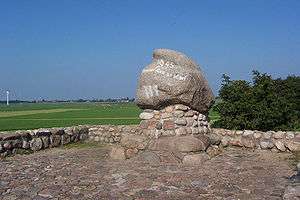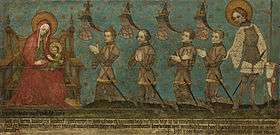Battle of Warns
| Battle of Warns | |||||||
|---|---|---|---|---|---|---|---|
 The monument of the battle of Warns in Friesland. It says, in Frisian, "Better to be dead than a slave". | |||||||
| |||||||
| Belligerents | |||||||
|
|
| ||||||
| Commanders and leaders | |||||||
|
|
| ||||||
| Strength | |||||||
| Unknown | Unknown | ||||||
| Casualties and losses | |||||||
| Unknown | Unknown | ||||||
The Battle of Warns (Frisian: Slach by Warns, Dutch: Slag bij Warns) was a battle from the Frisian-Hollandic War between count Willem IV of Holland and the Frisians which took place on 26 September 1345. The annual commemoration of the battle is important for many nationalist Frisians.
Attack
After the Hollandic counts completed their conquest of West Frisia they planned the conquest of Middle Frisia, most of the present province of Friesland.
In 1345 William IV, count of Holland, prepared a military action to conquer Middle Frisia, crossing the Zuiderzee with a large fleet and with the help of French and Flemish knights, some of whom had just returned from a crusade.
He set sail in Enkhuizen to cross the Zuiderzee, together with his uncle John of Beaumont, and landed near Stavoren and Laaxum. They planned to use the Sint-Odulphus monastery near Stavoren as a fortification. The Hollandic knights wore armour, but had no horses as there wasn't enough room in the ships, which were full of building materials and supplies. William's troops set fire to the abandoned villages of Laaxum and Warns and started to advance towards Stavoren.
In the countryside around Warns the Hollandic count was attacked by the local inhabitants. With their heavy armor the knights were no match for the furious Frisian farmers and fishermen. The path the Hollandic knights choose to flee led straight to the Red Cliffs.
As they fled they entered a swamp where they were decisively beaten. Their commander William IV of Holland was killed. When John of Beaumont heard what had happened, he ordered a retreat back to the ships. They were pursued by the Frisians and only a few made it to Amsterdam.
Tactical mistakes
The battle was marked by a number of tactical mistakes of the Hollanders. First, they divided their forces in two. William landed north of Stavoren and his uncle Jan landed south.
In addition, William continued the attack in haste without waiting for his archers. With a small group of 500 men he reached St. Odulphusklooster because the Frisians purposely moved back. But then they cut Willem from the bulk of his troops and defeated him.
After Count Willem was destroyed they turned against his main troops that couldn't flee because the ships were offshore. When these troops were defeated, they attacked John of Beaumont. He hadn't participated until then. The Frisians could beat him because his camp was chosen poorly with the sea in the back so that his army could never retreat. The Frisians took the battle with the Hollanders in the water where they beat them down.
Commemoration

The Battle of Warns was annually celebrated on September 26 until the 16th century, then it moved to the last Saturday of September on which it is celebrated nowadays by nationalistic Frisians. There is a monument on the Red Cliffs in Warns since 1951, a large glacial erratic with the text leaver dea as slaef [sic] (rather dead than slave). The road to Scharl is still called the ferkearde wei (the wrong way) by the local inhabitants because this was the way the Hollandic knights chose and led to their downfall.
The Battle of Warnsveld was the inspiration for the historical novel De Roos van Dekama by Jacob van Lennep.